Motorola TIMEPORT User Manual

Welcome
Thank you for choosing the Motorola Timeport™ phone from a global leader in communications technology.
All Motorola phones are designed and manufactured
to meet Motorola’s exacting specifications and world-class quality standards. During development, our laboratory
testing team took the durable Motorola Timeport™ phone design through its paces. They cooked it, steamed it, shook it, shocked it, dusted it, and dropped it—and the phone still worked! We are confident that the one you purchased can meet your own exacting standards.
Thank you for choosing the Motorola Timeport phone, and we hope you enjoy your new wireless digital phone!
1

Guide Overview
Okay, you’ve got a brand new phone with a bunch of nifty features.
Now what?
Afraid you’ll press the wrong key? Or forget a feature or two?
Don’t sweat it!
We’ve designed this guide to take you step-by-step through each feature of your new Motorola Timeport™
phone. We’ll show you what key to press and what happens when you press it. Follow along, chapter-by-chapter, and you’ll find it’s as easy as 1-2-3.
Here’s an idea of what you’ll learn in each chapter:
Getting Started
First things first. Once the box is open, this section will show you where to begin. We will explain what came with your new phone and show you how to use the battery. Turn to page 10 to get started.
The Basics
What do all those buttons and lights mean? How do I make my first phone call? In this section, we’ll answer those questions and teach you everything necessary to start using your new phone.
Begin learning “The Basics” on page 20.
Using Memory
Read “Using Memory,” beginning on page 34, and we will explain how to make the most of your new phone’s internal Phone Book. You’ll learn how to save time with dialing shortcuts and memory features that make it easy to place quick calls.
2

Guide Overview
Using Messaging *
This Motorola Timeport™ phone supports optional messaging services, like Caller ID, which allows you to see who is calling before you answer. It can even receive alphanumeric messages just like a pager and tell you when you have Voicemail. Turn to page 50 to begin “Using Messaging.”
Using the Minibrowser and Data Features*
With a service subscription, your phone can access up to the minute information with the Minibrowser! You can use the phone to retrieve on demand weather reports, sports scores, stock reports, and much more. See page 106.
With the addition of the Motorola Data Connectivity Kit, you can hook your phone up to a compatible computer and send and receive faxes and data. See page 114.
The Works
When you are ready to learn the advanced features of your new phone, turn to page 58 for “The Works.” We will explain everything from navigating the menu system to electronically locking your phone.
So relax!
Let us show you what your Motorola Timeport phone can do!
* Network and service dependent feature. Not available in all areas.
3

Contents Introduction
Guide Overview . . . . . . . . . . . . . . . . . . . . . . . . . . . . . . . 2
Safety Information . . . . . . . . . . . . . . . . . . . . . . . . . . . . 6
Getting Started
Package Content Options . . . . . . . . . . . . . . . . . . . . . . 10
Introduction to Batteries . . . . . . . . . . . . . . . . . . . . . . 12
Installing Batteries . . . . . . . . . . . . . . . . . . . . . . . . . . . 13
Charging Batteries . . . . . . . . . . . . . . . . . . . . . . . . . . . 14
Phone Overview . . . . . . . . . . . . . . . . . . . . . . . . . . . . . 18
Using the Smart Button . . . . . . . . . . . . . . . . . . . . . . . 19
The Basics
Turning Your Phone On . . . . . . . . . . . . . . . . . . . . . . . 20
Reading the Indicators. . . . . . . . . . . . . . . . . . . . . . . . 23
Placing and Ending Calls . . . . . . . . . . . . . . . . . . . . . 26
Redialing Numbers . . . . . . . . . . . . . . . . . . . . . . . . . . 27
Receiving Calls . . . . . . . . . . . . . . . . . . . . . . . . . . . . . . 28
Basic Tone Controls . . . . . . . . . . . . . . . . . . . . . . . . . . 30
Your Phone & Its Shortcuts . . . . . . . . . . . . . . . . . . . . 32
Using Memory
Introduction . . . . . . . . . . . . . . . . . . . . . . . . . . . . . . . . 34
Making the Most of Memory . . . . . . . . . . . . . . . . . . . 35
Storing . . . . . . . . . . . . . . . . . . . . . . . . . . . . . . . . . . . . 36
Entering Names . . . . . . . . . . . . . . . . . . . . . . . . . . . . . 37
Recalling. . . . . . . . . . . . . . . . . . . . . . . . . . . . . . . . . . . 38
Editing Memory . . . . . . . . . . . . . . . . . . . . . . . . . . . . . 40
Pause Dialing . . . . . . . . . . . . . . . . . . . . . . . . . . . . . . . 46
Using Calling Cards . . . . . . . . . . . . . . . . . . . . . . . . . . 48
4

Using Messaging |
Contents |
Introduction. . . . . . . . . . . . . . . . . . . . . . . . . . . . . . . . .50
Receiving Messages . . . . . . . . . . . . . . . . . . . . . . . . . . .51
Viewing Your Caller IDs . . . . . . . . . . . . . . . . . . . . . . . .52
Checking Your Voicemail. . . . . . . . . . . . . . . . . . . . . . .54
Reading Your Messages . . . . . . . . . . . . . . . . . . . . . . . .56
The Works
Introducing the Menu Features. . . . . . . . . . . . . . . . . .58
The Internal Phone Book . . . . . . . . . . . . . . . . . . . . . .60
Store and recall numbers
Using Call Timers . . . . . . . . . . . . . . . . . . . . . . . . . . . .68
Monitor the length of your calls
Setting Tone Controls. . . . . . . . . . . . . . . . . . . . . . . . . .74
Adjust your phone’s tone controls
Lock/Security Features. . . . . . . . . . . . . . . . . . . . . . . . .82
Control access to your phone
Phone Options . . . . . . . . . . . . . . . . . . . . . . . . . . . . . . .90
Personalize your phone’s operation
Using the Minibrowser. . . . . . . . . . . . . . . . . . . . . . . .106
Access valuable information with your phone
Using Data Features. . . . . . . . . . . . . . . . . . . . . . . . . .114
Make your phone a wireless modem
Reference Information
Accessory Options . . . . . . . . . . . . . . . . . . . . . . . . . . . .122
Troubleshooting. . . . . . . . . . . . . . . . . . . . . . . . . . . . .126
Glossary . . . . . . . . . . . . . . . . . . . . . . . . . . . . . . . . . . .130
Index . . . . . . . . . . . . . . . . . . . . . . . . . . . . . . . . . . . . .144
5

Exposure to Radio Frequency Signals
Antenna
Care
Safety Information
Important: Read this information before using your wireless handheld phone.
Your wireless handheld portable telephone is a low power radio transmitter and receiver. When it is ON, it receives and also sends out radio frequency (RF) signals. In August 1996, The Federal Communications Commission (FCC) adopted RF exposure guidelines with safety levels for handheld wireless phones. Those guidelines are consistent with safety standards previously set by both U.S. and international standards bodies:
•American National Standards Institute (ANSI) IEEE. C95.1 (1992).
•National Council on Radiation Protection and Measurements (NCRP). Report 86.
•International Commission on Non-Ionizing Radiation Protection (ICNIRP). (1996).
•Ministry of Health (Canada). Safety Code 6.
Those standards were based on comprehensive and periodic evaluations of the relevant scientific literature. For example, over 120 scientists, engineers, and physicians from universities, government health agencies, and industry reviewed the available body of research to develop the ANSI Standard (C95.1).
The design of your phone complies with the FCC guidelines (and those standards). For additional information concerning exposure to radio frequency signals, see the statement by the FDA at the end of this user guide. To maintain compliance with FCC RF exposure guidelines, if you wear a handset on your body, use the Motorola-supplied or approved carrying case, holster, or other body-worn accessory. If you do not use a body-worn accessory, ensure the antenna is at least one inch (2.5 centimeters) from your body when transmitting. Use of non-Motorola accessories may violate FCC RF exposure guidelines.
Use only the supplied or an approved replacement antenna. Unauthorized antennas, modifications, or attachments could damage the phone and may violate FCC regulations.
6
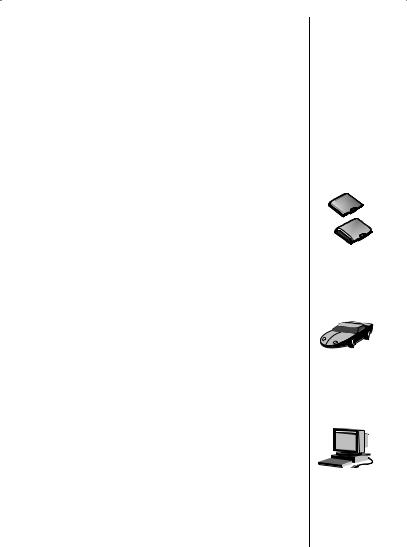
Safety Information
Normal Operation:
Hold the phone as you would any other telephone, with the antenna pointed up and over your shoulder.
Tips on Efficient Operation:
Observe the following guidelines to operate your phone most efficiently:
•Extend your antenna fully, if applicable.
•Do not touch the antenna unnecessarily when the phone is in use. Contact with the antenna affects call quality and may cause the phone to operate at a higher power level than otherwise needed.
Caution: All batteries can cause property damage, injury, or burns if a conductive material, such as jewelry, keys or beaded chains, touches exposed terminals. The material may complete an electrical circuit and become quite hot. To protect against such unwanted current drain, exercise care in handling any charged battery, particularly when placing it inside your pocket, purse, or other container with metal objects. When the battery is detached from the phone, your batteries are packed with a protective battery cover; please use this cover for storing your batteries when not in use.
Check the laws and regulations on the use of wireless telephones in the areas where you drive. Always obey them. Observe the following guidelines when using your phone while driving.
•Give full attention to driving–driving safely is your first responsibility;
•Use hands-free operation, if available;
•Pull off the road and park before making or answering a call if driving conditions so require.
Most modern electronic equipment is shielded from RF signals. However, certain electronic equipment may not be shielded against the RF signals from your wireless phone.
Pacemakers
The Health Industry Manufacturers Association recommends that a minimum separation of six inches (6") be maintained between a handheld wireless phone and a pacemaker to avoid potential interference with the pacemaker. These recommendations are consistent with the independent research by and recommendations of Wireless Technology Research.
Phone
Operation
Batteries
Driving
Electronic
Devices
7

Vehicles
Posted
Facilities
Aircraft
Blasting
Areas
Safety Information
Persons with pacemakers:
•Should ALWAYS keep the phone more than six inches from their pacemaker when the phone is turned ON;
•Should not carry the phone in a breast pocket;
•Should use the ear opposite the pacemaker to minimize the potential for interference.
•Should turn the phone OFF immediately if you have any reason to suspect that interference is taking place.
Hearing Aids
Some digital wireless phones may interfere with some hearing aids. In the event of such interference, you may want to consult your hearing aid manufacturer to discuss alternatives.
Other Medical Devices
If you use any other personal medical device, consult the manufacturer of your device to determine if it is adequately shielded from external RF energy. Your physician may be able to assist you in obtaining this information.
Turn your phone OFF in health care facilities when any regulations posted in these areas instruct you to do so. Hospitals or health care facilities may be using equipment that could be sensitive to external RF energy.
RF signals may affect improperly installed or inadequately shielded electronic systems in motor vehicles. Check with the manufacturer or its representative regarding your vehicle. You should also consult the manufacturer of any equipment that has been added to your vehicle.
Turn your phone OFF in any facility where posted notices so require.
Switch OFF your phone before boarding an aircraft. Airline regulations prohibit using your phone while in the air. Check and comply with the policy of your airline regarding the use of your phone while the aircraft is on the ground.
To avoid interfering with blasting operations, turn your phone OFF when in a "blasting area" or in areas posted: "Turn off two-way radio." Obey all signs and instructions.
8

Safety Information |
Potentially |
Turn your phone OFF, do not remove your battery when you are in any |
|
area with a potentially explosive atmosphere, and obey all signs and |
Explosive |
instructions. Sparks from your battery in such areas could cause an |
Atmospheres |
explosion or fire resulting in bodily injury or even death. |
|
Areas with a potentially explosive atmosphere are often but not always |
|
clearly marked. They include: fueling areas such as gasoline stations; |
|
below deck on boats; fuel or chemical transfer or storage facilities; areas |
|
where fuel odors are present (for example, if a gas/propane leak occurs in |
|
a car or home); areas where the air contains chemicals or particles, such |
|
as grain, dust, or metal powders; and any other area where you normally |
|
would be advised to turn off your vehicle engine. |
|
An air bag inflates with great force. Do NOT place objects, including both |
Vehicles |
installed or portable wireless equipment, in the area over the air bag or in |
Equipped |
the air bag deployment area. If in-vehicle wireless equipment is |
with Air |
improperly installed and the air bag inflates, serious injury could result. |
Bags |
|
|
|
|
9
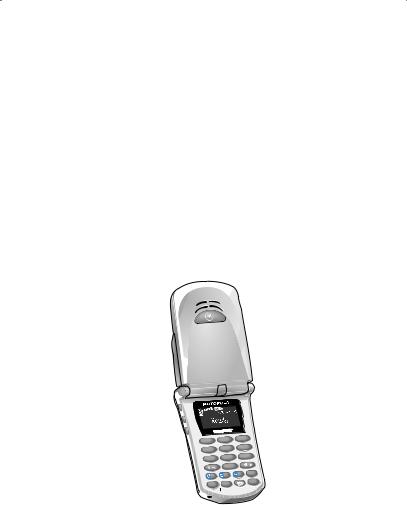
Getting Started
The Motorola Timeport™ phone comes equipped with a standard battery and an AC adapter to get you up and running. An exciting line of accessory options can customize your wireless package for maximum performance and portability. This chapter will show you how to get started with your new wireless package.
In this chapter we will explain how to:
•Attach and charge batteries.
•Use chargers.
|
1 2 2 5 |
|
|
MENU |
2ABC |
3DEF |
|
1 |
|
|
|
|
|
|
MUTE |
BATT |
LOCK |
6MNO |
|
4GHI |
5 JKL |
|
|
7PQRS |
VIB |
9WXYZ |
|
8TUV |
|
|
|
|
0 OPR |
|
|
RCL |
STO |
CLR |
SEND |
|
|
||
PWR |
FCN |
|
END |
|
|
||
Motorola Timeport™ Phone
10
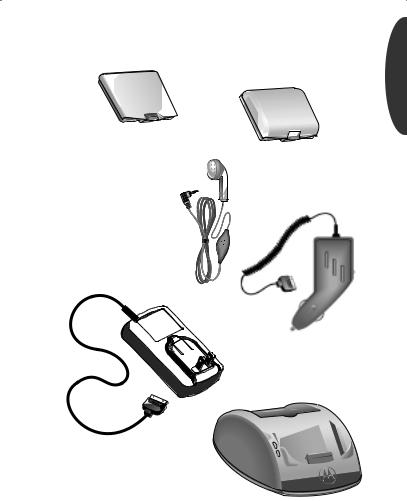
Package Content Options
Started Getting
Slim LiIon Battery
Standard LiIon Battery
Headset
Vehicle Power
Adapter
AC Adapter
Desktop Charger
(AC adapter required)
Your phone and accessories may not look exactly as pictured.
11
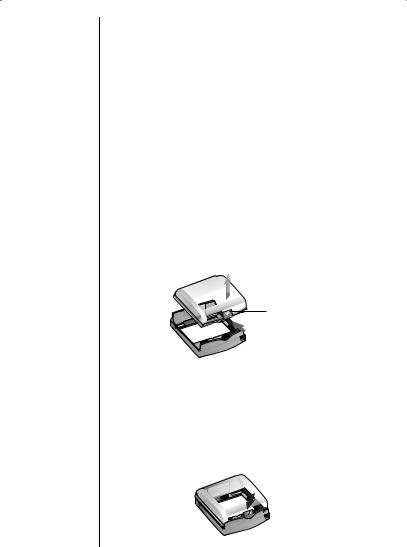
Introduction to Batteries
Each battery is shipped in an uncharged state with a protective clip on it. Before you can use your phone, you will need to remove the clip from the battery and charge it.
Battery Clips
It is a good idea to save the protective clip to store and carry the battery when not in use. The clip prevents objects from touching the battery terminals, thereby reducing the risk of injury or damage from a short circuit.
Removing the Main Battery Clip
1.Press In Press in the release latch.
Latch
2.Remove Rotate the battery upward and lift it out of Battery the protective clip.
|
2. |
|
Release Latch |
|
1. |
Attaching the Main Battery Clip |
|
1. Lower |
Lower the side opposite the release latch into |
Side |
the clip. |
2.Click Drop the side with the release latch down Latch until the latch clicks.
1. 
2.
12
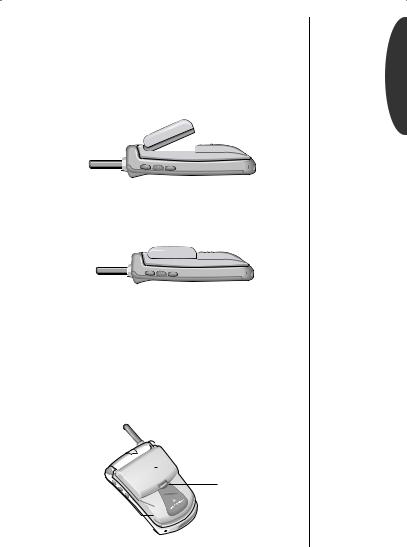
Installing Batteries
Battery Installation
To install a battery:
1. Insert |
Place the side of the battery opposite the |
Toe |
release latch into the compartment. |
1.

2.Snap Press the side with the release latch down Heel until you hear it click into place.
2.
Battery Removal
To remove a battery:
1. Turn OFF |
If necessary, press and hold ¡to turn your |
Phone |
phone OFF. |
2.Remove Pull the release latch back toward the battery Battery and lift the battery out.
Release Latch
Started Getting
13
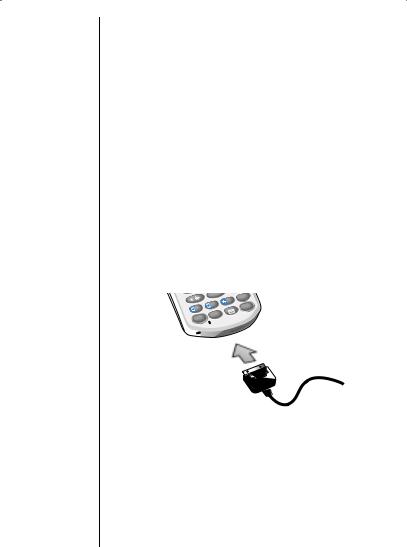
Important:
We recommend keeping the phone closed when connected to an external power supply, like a charger or vehicle accessory.
Charging Batteries
Using the Internal Rapid Charger
Believe it or not, there is a battery charger built right into your phone! To make use of the internal charger, you will need either an AC adapter or a vehicle power adapter.*
Keep in mind: When the internal charger is in use and the phone is ON, you can still place and receive calls. However, talking on the phone requires energy, so your phone may not charge while the call is in progress.
1.Attach Plug the AC or vehicle power adapter into Adapter to the accessory connector on the bottom of Phone your phone as shown, with the release tab
facing up.
2.Plug In Plug the adapter into the appropriate power Adapter source. Your phone will beep to let you know
the AC adapter is connected on both ends.
|
0 OP |
|
|
R |
|
|
|
SEND |
|
|
CLR |
|
STO |
END |
RCL |
|
|
|
FCN |
|
PWR |
|
|
H
PUS
TOP
Keep in mind: In some cars, the ignition must be ON to use the vehicle’s** accessory power.
*Check with your retailer for availability of the adapters.
**The use of wireless devices and their accessories (“devices”) may be prohibited or restricted in certain areas. Always obey the laws and regulations on the use of these
devices.
14
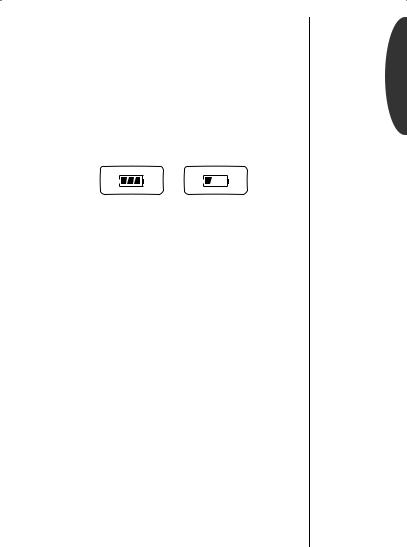
Charging Batteries
The Battery Indicator
In the upper right corner of your phone’s display, there is a battery indicator filled with three segments. The more segments you see, the greater the charge.
•The border of the battery icon will flash during charging.
•When the battery is fully charged, the battery icon will stop flashing and become solid.
High Low
Battery Storage and Disposal
To prolong the life of batteries, avoid exposing them to temperatures below -10°C (14°F) or above 45°C (113°F). It is a good idea to take your phone with you when you leave your car. Never dispose of batteries in fire. To dispose of batteries, contact your local recycling center.
Caution: To prevent injuries or burns, do not allow metal objects to contact or short circuit the battery terminals.
Expert Performance (E•P®)Charging System
The E•P system enables your phone’s built-in charger to communicate with installed batteries and tailor its charging cycle to optimize performance. If you see Invalid Battery when you power up the phone, the built-in charger is not able to communicate with the battery and cannot charge it. There are several possible reasons for this message. The most likely one is that the battery is not a Motorola original and it does not have the appropriate E•P technology. We recommend that you use only Motorola original batteries and accessories and that you store your batteries in their protective clips when not in use.
Started Getting
15
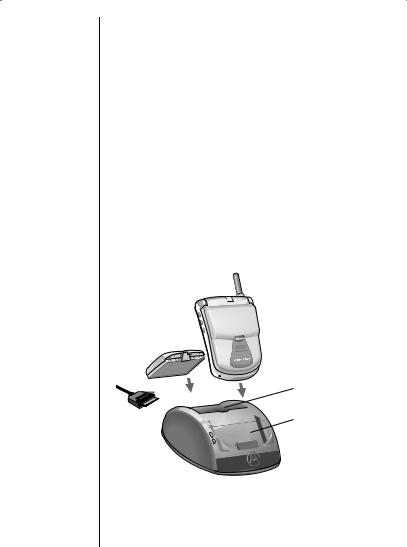
Important:
We recommend keeping the phone closed when connected to an external power supply, like a charger or vehicle accessory.
Charging Batteries
Using the Desktop Charger
The Desktop Charger’s front pocket can charge batteries while they are attached to your phone, and the rear pocket can charge batteries separately.
If you have a Desktop Charger:
1.Attach Plug the AC adapter into the back of the Adapter charger, with the release tab facing up.
2.Plug In Plug the other end of the AC adapter into a
Adapter |
wall socket. |
3.Insert Insert the phone into the front pocket with a Phone battery attached.
&Insert If you like, insert a battery into the rear
Battery pocket.
Rear Pocket
PUSH
Front Pocket
Note: If two batteries are loaded in the charger, the batteries will charge one at a time, the battery loaded in the front pocket followed by the battery in the rear pocket.
16

Charging Batteries
Desktop Charger Indicators
The LED indicators on the left front of the Desktop Charger let you know the current state of any charging batteries.
The Front Pocket LED Indicator:
•Yellow means the phone with a battery is securely installed.
•Open the phone to see the charge status for the front pocket.
The Rear Pocket LED Indicator:
•Red means the battery is charging.
•Flashing yellow means the battery is waiting to be charged.
•Green means the battery is charged to 90% of its capacity. Another hour of charging will bring it up to 100% capacity.
•Flashing red means the battery is damaged and cannot be charged.
Desktop Charger Charging Times
The time it takes for your battery to obtain a full charge is affected by a variety of factors, including:
•Temperature Batteries should be at or near room temperature when charging. To prolong battery life and charge capacity, avoid exposing your batteries to temperatures below -10°C (14°F) or above 45°C (113°F). It is a good idea to take your phone with you when you leave your car.
•Inactivity New batteries, or batteries that have been stored for long periods of time, may not rapid charge properly. In these instances, the battery requires an overnight charge.
•Extended Usage Over extended periods of time, batteries gradually wear down and require longer charging times. This is normal. If you charge your battery regularly and notice a decrease in talk-time or an increase in charging time, then it is probably time to purchase a new battery.
Tip:
See pages 24-25 to learn how to read the display.
Important:
We recommend keeping the phone closed when connected to an external power supply, like a charger or vehicle accessory.
Started Getting
17

Phone Overview
Function Keys
¡
ø
Turns the phone ON and OFF.
Opens messaging menus.
ƒActs as a “shift” key to access the secondary functions of other keys.
‰Recalls phone numbers from memory and acts as the left soft key for Minibrowser navigation.
¬Stores phone numbers into memory and acts as the right soft key for Minibrowser navigation.
Ç Clears characters from the screen.
º Ends phone calls and exits the menu.
ª Places or answers calls. Your phone will have one of æ these two keys.
« Can be used to scroll through memory entries » and menu features.
Alphanumeric Display Displays your input from the keypad, information recalled from memory, and other messages.
Microphone Positioned for convenient conversation.
Retractable Antenna Extend for best performance.
Earpiece Ultra-compact phone speaker.
Headset Jack Connects an optional headset.
Accessory Connector Provides the connection for an external power supply.
Volume Keys Located left of the display and represented in the manual by q and Z, these keys adjust the volume and scroll up and down through memory locations and menu features.
18
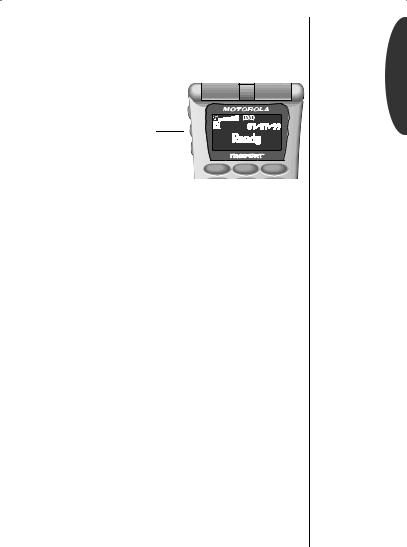
Using the Smart Button
When in doubt, press the smart button! Easily recognized in this User’s Guide by Aand in your phone’s display by § – the handy smart button puts a variety of functions at your fingertip.
|
1 2 |
2 5 |
The Smart Button |
|
|
1MENU |
2ABC |
3 DEF |
Use the smart button’s fingertip convenience for:
Opening the Quick Menu
Press Awhen your phone is idle to display a menu containing shortcuts to your phone’s most popular features. See page 32.
Opening Your Phone Book
Press Atwice to open the Phone Book with your names and numbers. Turn to page 38 in “Using Memory” to learn more.
Entering the Menu System
Press ƒthen press Ato enter your phone’s menu system. See page 58 for information on navigating the menu system.
Selecting Items in the Menu
The primary use of the smart button is to select. Whenever the phone offers you a choice, such as setting a ringer style (pg. 77), press Ato select. You will see: Press § to Select.
Turning Features ON and OFF
Press Ato toggle ON and OFF many menu features, like the call timers (pg. 68). You will see: Press § to Toggle.
Placing and Ending Calls
Press and hold Ato place a call when the number you want to call is on the display. Press and hold Aagain to end a call. See page 26 for information on placing and ending calls.
Started Getting
19

The Basics
The next few pages will introduce you to the basic features of your phone. In the chapters that follow, we will explain every one of your phone’s features, including storing names and numbers, using the call timers, locking the phone, and more.
In this chapter we will explain how to:
•turn your phone ON.
•read the indicators.
•place, receive and end calls.
•adjust ringer and keypad volume, use shortcuts, and more.
Turning Your Phone On
Follow these steps to turn your phone ON:
1. Extend Extend the antenna completely for best Antenna performance.
2.Open Open the phone to expose the keypad.
Phone
3.Turn ON Press ¡once to turn the phone ON.
Phone
4.Turn OFF When finished, press ¡again to turn the
Phone |
phone OFF. |
Press ¡to turn the phone ON or OFF
|
0 OPR |
|
|
RCL |
STO |
CLR |
SEND |
PWR |
FCN |
|
END |
20

Turning Your Phone On
Activating Your Phone
The first time you turn your phone ON, you may see a message on the display:
1 2 |
2 5 |
1 2 |
2 5 |
Basics
If you see these messages on the display, your service activation can be completed with just a couple simple steps:
1. Place Press æ(or ª) to place the call.
Call or
Press and hold Auntil you hear a high tone.
2.Follow Once the connection is made, your phone Steps will begin activation. Contact your Service Provider for further assistance.
If you do not see Activation Required, your phone was activated at the time of purchase and there is no need to follow the steps above.
Power Up Display
Once activated, each time you turn your phone ON, your phone performs a short self-test to make sure it is operational and then it scans for service. While the phone scans, the display reads:
NS
Turn the page to learn more about turning your phone ON.
21
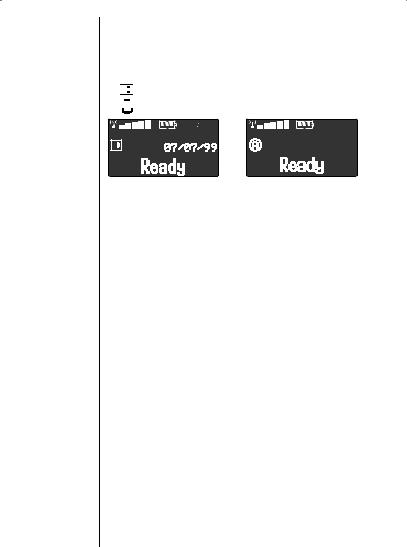
Tip:
Look for Rm on the second line to know if you are roaming. See page 25 for more info.
Tip:
You can choose how long the backlight remains ON. See page 99.
Turning Your Phone On
To make the best use of available signals, your phone can operate on both analog and CDMA digital systems. If your phone finds a CDMA digital system, you will see the time and date and the 


 icon. If your phone finds an analog system, you will see the
icon. If your phone finds an analog system, you will see the 



 icon.
icon.
1 2 |
2 5 |
|
|
Digital |
Analog |
|
|
||
|
|
||
|
|
Quad Number
Your phone can be activated with up to four unique phone numbers. If more than one number is programmed, you will see the currently active number whenever you turn ON the phone. Turn to Changing Your Number on page 92 if you want to change the active number.
Roaming
If your home network is not available when you turn your phone ON, your phone will briefly display: Roaming.
Power Save Mode
If you travel outside the range of available networks, your phone continues to search for a signal. To save power, it stops searching every couple of minutes. When this is the case, you will see:
Power Save. Your phone will automatically begin searching again in a minute or two – if you would like it to start searching immediately, just press any key.
Standby Mode
To conserve energy, your phone enters standby mode and turns OFF the backlight when you have not touched a key for a few seconds. The backlight will come back ON as soon you press a key or open the phone.
22
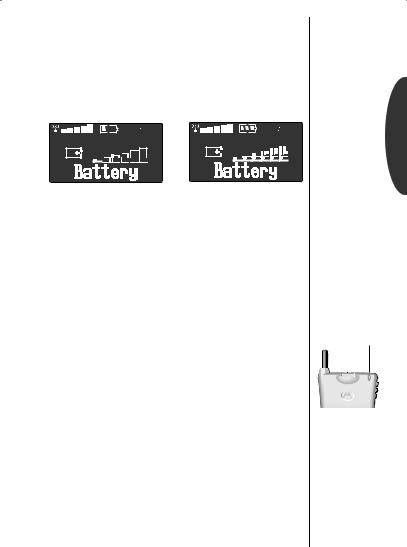
Reading the Indicators
Detailed Battery Level Reading
Press ƒthen press ›.
The bar graph in the display represents the battery level. The higher the graph, the closer the battery is to full charge.
1 2 |
2 5 |
1 2 |
2 5 |
|
|
|
|
|
|
|
|
|
|
|
|
|
|
|
|
|
|
|
|
|
|
|
|
|
|
|
|
|
|
|
|
|
|
|
|
|
|
|
|
|
|
|
|
|
|
|
|
|
|
|
|
|
|
|
|
|
|
|
|
|
|
|
|
|
|
|
|
|
|
|
|
|
|
|
|
|
|
|
|
|
|
|
|
|
|
|
|
|
|
|
|
|
|
|
|
|
|
|
|
|
|
|
|
|
|
|
|
|
|
|
|
|
|
|
|
|
|
|
|
|
|
|
|
|
|
|
|
|
|
|
|
|
|
|
|
|
|
|
|
|
|
|
|
|
|
|
|
|
|
|
|
|
|
|
|
|
|
|
|
|
|
|
|
|
|
|
|
|
|
|
|
|
|
|
|
|
|
|
|
|
|
|
|
|
|
|
|
|
|
|
|
|
|
|
|
|
|
|
|
|
|
|
|
|
|
|
|
|
|
|
|
|
|
|
|
|
|
|
|
|
|
|
|
|
|
|
|
|
|
|
|
|
|
|
|
|
|
|
|
|
|
|
|
|
|
|
|
|
|
|
|
|
|
|
|
|
|
|
|
|
|
|
|
|
|
|
|
|
|
|
|
|
|
|
|
|
|
|
|
|
|
|
|
|
|
|
|
|
|
|
|
|
|
|
|
|
|
Low Charge |
|
|
|
Full Charge |
|
|
|
||||||||||||||||||||||||
Note: When plugged in, the battery level is rounded to the lowest bar for increased accuracy. When you first attach the AC adapter, the level may fall.
Important: If the phone is being powered externally–from the vehicle power adapter for example–you will see: Charging.
Service Light
The Service Light is on top of your phone and lights up when your phone is ON. The color it flashes depends on your phone’s current state of service.
Red & Green, |
Incoming call or message |
|
alternating |
||
|
||
|
|
|
Green, flashing |
In Service: home type system |
|
|
|
|
Red, flashing |
No Service |
|
|
|
|
Yellow, flashing slow |
Roaming: home type system |
|
|
|
|
Yellow, flashing fast |
Roaming: non-home type system |
|
|
|
Service
Light
Tip:
To increase your phone’s standbytime, you can turn the Service Light OFF. See page 101.
Basics
23
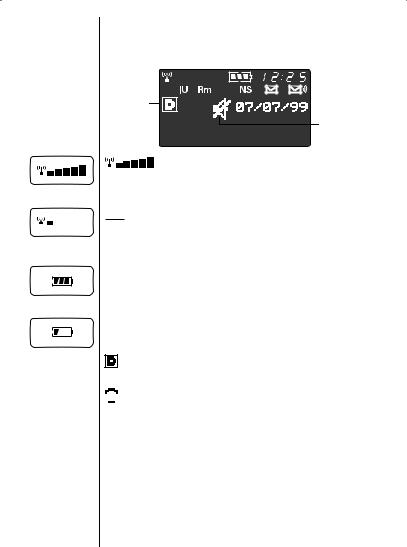
Reading the Indicators
1 |
|
|
|
|
|
|
2 |
|
|
|
3 |
|
|||||
|
5 |
6 |
|
7 |
8 |
|
9 |
||||||||||
|
|
|
|
|
|
|
|
|
|
|
|
|
|
|
|
|
|
|
|
|
|
|
|
|
|
|
|
|
|
|
|
|
|
|
|
|
|
|
|
|
|
|
|
|
|
|
|
|
|
|
|
|
|
|
|
|
|
|
|
|
|
|
|
|
|
|
|
|
|
|
|
|
|
|
|
|
|
|
|
|
|
|
|
|
|
|
|
|
|
|
|
|
|
|
|
|
|
|
|
|
|
|
|
|
|
|
|
4 |
10
|
Signal Strength (1) |
Strong |
Displays the strength of the connection between your phone and |
the wireless network. |

 Battery Level (2)
Battery Level (2)
The three bar segments on the phone’s Battery Level Indicator Weak show the amount of charge remaining in your battery at a
glance. The more bar segments you see, the higher the charge.




 Clock (3)
Clock (3)
When your phone is on a CDMA digital network, the display
Batt - High
shows the current time and date. Wherever you are, you will have the correct local time. You can set your clock for 12or 24hour format. See page 100 for more information.
Batt - Low
Digital (4)
Indicates you are receiving a digital signal.




 Analog (4)
Analog (4)
Appears when you are on an analog channel.
24

Reading the Indicators
IU In Use (5)
Appears when a call is in progress.
Rm Roam (6)
Lights up when your phone accesses a wireless service outside of your home system. When you leave your wireless Service Area, your phone roams (seeks another wireless system).
NS No Service (7)
Appears when calls cannot be placed or received from your location.
 Message (8)
Message (8)
Appears when you receive an alphanumeric message.* It will disappear after you have viewed the message.
 Voicemail (9)
Voicemail (9)
Indicates that you have received a Voicemail* message in your Voicemailbox. It will disappear after you have checked your Voicemail.
When you select one of the VibraCall® alert combinations (see page 76), the following indicators appear in the display:
VibraCall® Alert On (10)
Indicates that your phone’s ringer is turned OFF and the VibraCall alert is ON.
Silent Mode (10)
Indicates that all of your phone’s tones are silenced and the VibraCall alert is ON.





 Vibrate Then Ring (10)
Vibrate Then Ring (10)
Indicates that both the ringer and VibraCall® alert are ON.
* Network and service dependent feature. Not available in all areas.
Basics
25

Tip:
If you press æ (or ª) without entering a number, your phone will dial the last number entered.
Placing and Ending Calls
Placing a Call
1. Extend Extend the antenna completely for best Antenna performance.
2.Open Open the phone to expose the keypad. Phone If necessary, press ¡to turn the phone ON.
3.Enter Enter the number you want to call, Number for example: 555-1212.
Correct Press Çto erase one digit at a time if you Errors make a mistake. Press and hold Çto erase the entire entry and start again.
4.Place Press æ(or ª) to place the call.
Call or
Press and hold Auntil you hear a high tone. You will see: Calling 555-1212.
You can dial phone numbers with up to 32 digits, but only the last twenty-four digits will appear in the display.
Press ‰to see the rest of the number.
Your phone will display the first 24 digits, then a second screen will show the digits remaining in the phone number.
Ending a Call
There are three ways to end a call:
|
Close |
Close the phone to end a call. |
or |
Press Key |
Press º. |
or |
Hold |
Press and hold Auntil you hear a high tone. |
|
Smart |
You will see: Press § to End Call. |
|
Button |
Press Aagain to end the call. |
26

Redialing Numbers
Automatic Redial
The wireless system may at times be too busy to handle your call. If this is the case, you may hear a fast busy signal and see
Call Failed and Press SND to Redial. With Automatic Redial, your phone will repeat the call attempt over the next four minutes. When the call succeeds, your phone will ring or vibrate until the person you are calling answers.
Auto Press æ(or ª) or press and hold A Redial until you hear a high tone.
You will see: Redialing.
To make this feature even easier, turn Instant Redial ON. Your phone will instantly redial after a fast busy signal, and you will not have to push a button. To find out more, see page 97.
Redial
If you hear an ordinary busy signal:
1.Hang Up Press ºto hang up.
2.Redial Press æ(or ª) to redial or press and
hold A. You will see: Calling.
Display Last Ten Numbers Dialed
Your phone keeps track of the last ten numbers you have dialed.
1. |
Enter |
Press ‰then press ‚, ‚. The dis- |
|
List |
play will show the last number you dialed. |
2. |
Review |
Press qor Zto scroll through the last calls |
|
List |
made, including the time, date, and number. |
3.Call Press æ(or ª) or press and hold A to Number call the number in your display.
You will see: Calling.
Basics
Tip:
Your phone’s Scratchpad automatically remembers the last number entered. See page 45 to learn more.
Tip:
This feature is also available through the Quick Menu. See page 32 to learn more.
27

Receiving Calls
Your phone must be ON to receive calls.
When a call is incoming:
•an alert will sound and/or vibrate.
•the Service Light (pg. 23) will flash red and green.
You can choose your phone’s alert, selecting from nine ringer styles or silent vibration mode. See page 77.
Answering a Call
To answer a call:
1. Extend Extend the antenna completely for best Antenna performance.
2.Open Open the phone to expose the keypad.
Phone or
Press æ(or ª) if the phone is already open.
Caller ID
If you subscribe to Caller ID* through your Service Provider, you will be able to see who is calling before you answer. The display will show your caller’s name if it is in your Phone Book. If not, the display will show your caller’s number. If you prefer to always see your caller’s number, see page 65 to turn Number Preference ON.
1 2 |
2 5 |
1 2 |
2 5 |
The Caller IDs for your last 16 callers will be saved. See page 52 to learn how to view your stored Caller IDs.
* Network and service dependent feature. Not available in all areas.
28

Receiving Calls
Ringer/Vibrating Alert Suppress
If an incoming call catches you by surprise, you can silence the alert using the upper or lower volume key. Your phone’s ringer or vibrating alert will remain OFF while the current call lasts. The caller will still hear ringing and you can still answer the call by pressing æ(or ª).
Suppress When the phone rings or vibrates, press the Alert upper or lower volume key.
Note: This feature works the same with a headset. To answer the call with a headset after you have turned the alert OFF, press either volume key again or the smart button.
Unanswered Call Indicator
Even with the latest wireless technology, sometimes you are unavailable to answer calls. If your phone is ON, it keeps a count of unanswered calls. For example, if you miss two calls, your display will show: 2 Calls Unanswered.
Clear Press Çor press ºto clear the display, Display and you can begin placing calls again.
Call Waiting
If you subscribe to Call Waiting through your Service Provider, you may hear a tone while on a call, indicating that you are receiving a second call.
Answer |
Press æ(or ª) to answer the call and |
Call |
automatically place the current call on hold. |
or End |
Press ºto end the current call. Your phone |
Current |
will then ring and/or vibrate as usual. Press |
Call |
æ(or ª) to answer the call. |
Tip:
If you subscribe to Caller ID service, you can easily return the calls that you missed. See page 52 to learn how.
Basics
29

VibraCall
Alert ON
Silent
Mode ON
Tip:
See page 76 for the Silent Mode menu option.
Basic Tone Controls
Vibration Mode
In situations where ringing may not be appropriate, or in noisy places where you may not hear your phone, select the VibraCall® alert. Ringing will be replaced by gentle vibrations.
Toggle Press ƒthen press †to switch Alert between the ringer and vibrating alert.
Silent Mode
For complete discretion, turn Silent Mode ON. All tones will be silenced. You can dial silently, and the ringer will be replaced by vibrations.
Activate Press ƒthen press and hold †until you
Silent see: Silent Mode On.
Mode
Turn OFF Press ƒthen press †to turn Silent Mode OFF. Your phone will return to Ring Only mode.
Muting the Microphone
If you would like privacy while a call is in progress, you may mute the microphone—you will be able to hear the party on the other end, but they will not hear you.
Mute Press ƒthen press flduring a call to Phone mute the microphone. You will see: Muted.
Unmute Press ƒthen press flagain to Phone resume your conversation.
30
